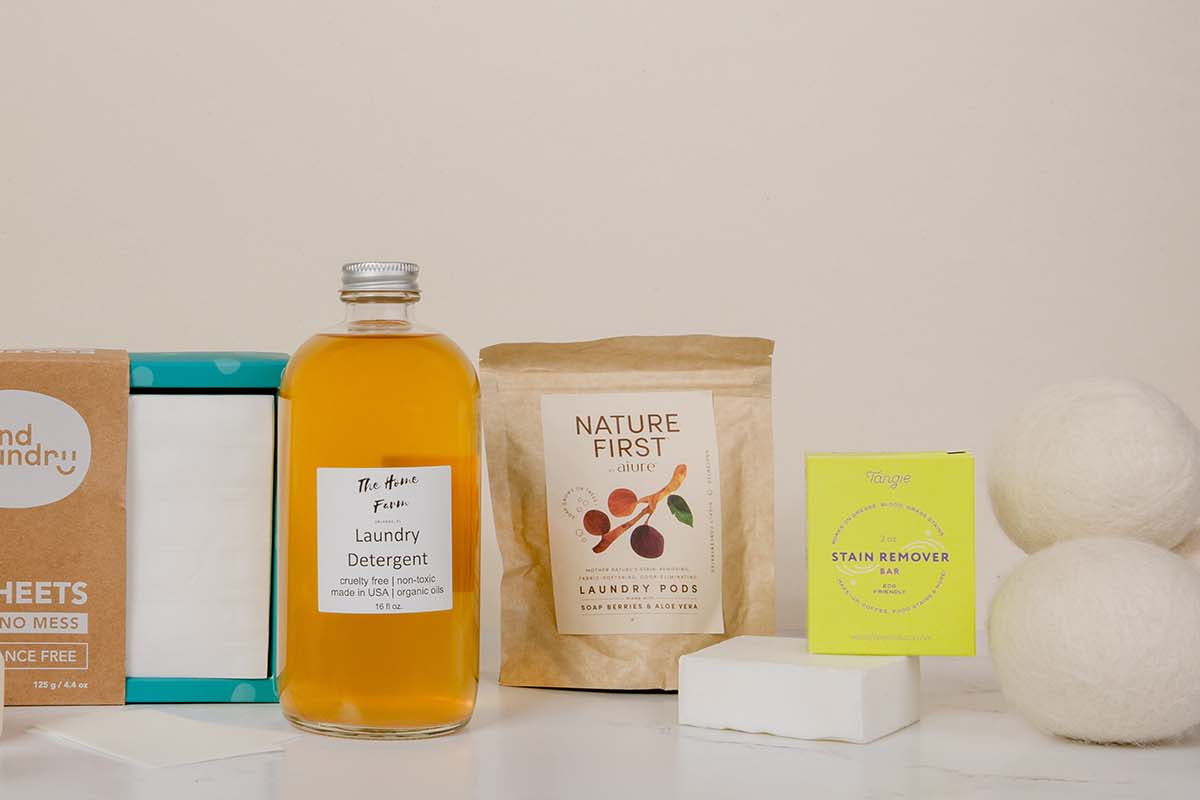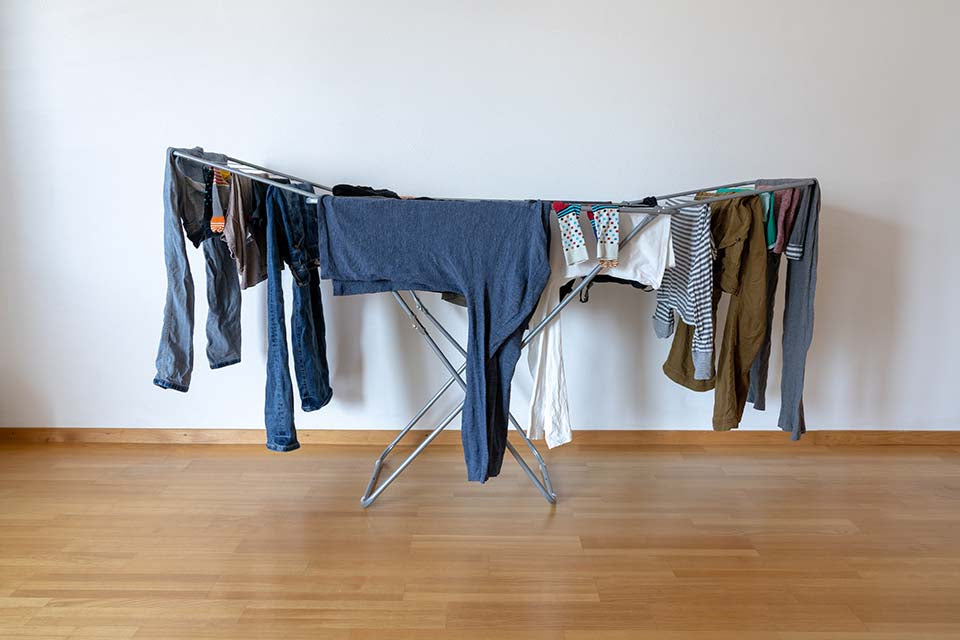8 Easy Steps For A Sustainable Laundry Routine

Create a sustainable laundry routine that protects your clothes, gets them clean, and helps the planet.
Estimated Read Time: 7 minutes
Laundry seems the ultimate right of passage. Once you start doing your own you’ve firmly planted your foot in the adult world. And when someone doing your laundry for you makes you feel warm and fuzzy inside then you know you’ve really entered the adult world.
But when life gets going, rather than feeling like you’re doing the laundry, it can feel like you’re wading in it, barely able to stay afloat. Putting a sustainable laundry routine in place can help you feel more on track and more in control!

Photo by PlanetCare on Unsplash
Creating a sustainable laundry routine is important to help reduce the stress around laundry, the routine part of it can make you feel more in control and even give you precious time back in your day. Having a laundry routine can help you keep the process as stress free as possible, and making it a sustainable one can help the planet!
But creating a sustainable laundry routine isn’t just about the products you use, it’s also about how you treat your clothes, your machines, water temperature, and more.
Read on to find out how to create a sustainable laundry routine.
1. Sustainable Laundry Routines Start With A High Efficiency Washer
(If possible). We are by no means telling you to go out and buy a new machine, and if you’re renting that’s not even possible. But if you’re in the market for a new machine, invest in a high efficiency (HE) washing machine.
HE washers require less water and less energy while being able to wash more per load. Switching to an Energy Star front-loading machine can save as much as 33% of the water used during the washing process.
If you aren’t in a position to switch to an HE machine, you can still have a sustainable laundry routine by following the rest of the steps!

Photo by Annie Spratt on Unsplash
Additionally make sure you’re taking care of the machine you do have by doing routine cleanings to keep it in great working condition and lasting as long as possible!
You can always Google a video to clean your washer, but an easy cleaning routine is:
- 2 cups vinegar in the detergent dispenser (or drum) and run the washer on the highest, longest, and hottest setting.
- Then add ½ cup baking soda inside the drum and run again on the highest, longest, and hottest setting.
- Be sure to wipe down the doors, knobs, and get inside any rubber seals.
- Keep the washer door open or propped up after doing a load to prevent mold and mildew from building up.
2. Washing Your Clothes Less Often Is Key To A Sustainable Laundry Routine

Photo by Jason Leung on Unsplash
Chances are you’re washing your clothes a lot more than you need to, denim included. The rule of thumb is if it comes into contact with bodily fluids, heavy sweat, or you can visibly see dirt, then it should be washed. Denim should be washed every 10 wears or 6 weeks.
Washing more than this can contribute to your clothes wearing down faster, using unnecessary water and energy, and shedding microplastics from your clothes into the water stream.
Some fabrics shouldn’t be washed at all which is a great opportunity to give hand-washing your clothes a try. It’s also great when you need just a couple of things washed instead of running an entire load.
3. Wash clothes in cold water

You might have learned to do laundry in separate loads with separate colors and different temperatures. But the truth is, hot water uses a lot of energy and can actually damage your clothes and fabric, especially over time. You can get your clothes just as clean using cold water and a detergent. In fact, roughly 34 million tonnes of carbon emissions could be saved if everyone switched to cold water for laundry.
*Note if a family member is sick, it’s recommended to wash in hot water and use a sanitizer such as vinegar*.
4. Use A Non-spray Stain Remover

Cold water is actually better for stain removal as well, and this plant-based stain stick is all you need for any stain! This 3 oz bar is made with ingredients such as coconut oil, soap nuts liquid, and sea salt for scrubbing power. It easily removes grass, mud, grease, blood and more. If you need some extra scrubbing power, the zero waste vegetable brush is an excellent shape and texture for rubbing out stains.
To use:
Wet the fabric with the stain, rub the bar directly on the stain, and toss in laundry as normal
5. Switch To An Eco-Friendly Detergent For A Sustainable Laundry Routine

This is a topic we could talk about for a while, and have on our blog! But our favorite zero waste laundry detergent is these laundry sheets from Kind. No more measuring, no spills, and forget worrying if you put too much or too little detergent. One sheet = one load, it’s as easy as that. They’re suitable for both HE and regular washing machines!
To use:
Place one laundry sheet in the drum with clothes, select settings and run as usual. For extra cleaning power, add two sheets. For XL loads, such as bedding, add three sheets.
When using an HE machine, be sure you’re using compatible detergents. Using non-HE detergents in a high efficiency machine can actually create too many suds and confuse the machine. This can cause your clothes to not fully rinse and allow the suds to linger in the machine.
6. Capture Microfibers and Microplastics with A Guppyfriend Washing Bag

With each wash, our synthetic fibers shed and pass through our water treatment facilities. Because these fibers are so small, they pass through these facilities and filters and eventually end up in our waterways and oceans. Microplastics and microfibers have been found on beaches from the Great Lakes to the Pacific Islands.
Washing your synthetic fabrics in this washing bag prevents microfibers from leaking into waterways and helps prevent fabrics from shedding during the washing process!
To use:
Place clothes inside Guppyfriend washing bag and run load on regular settings. After the load is complete, remove clothes from the bag and throw away the microfibers remaining.
7. Consider Skipping The Dryer

If using hot water increases energy usage, imagine how much energy a dryer, which is just hot air for an extended period of time, uses. It’s estimated that dryers use 5-10 times more energy than a washing machine. Try setting your laundry on an extra spin cycle and letting your clothes air dry. Not only is it better on the planet, it’s actually better on your clothes!
If you can’t line dry for all your clothes, try starting with certain groups at a time — synthetic fibers (think workout gear), wools, linens, and cotton are a great place to start.
8. Add Dryer Balls To Reduce Dry Time
If you aren’t able to line dry all of your clothes, there are ways to maximize the efficiency of your dryer. Clean out the lint collector frequently which helps the air flow and assists in drying your clothes faster (not to mention prevents fires).

Additionally, add in Wool Dryer Balls to your load to help break up the clothes and lower your dry time.
To help increase efficiency we also recommend skipping the fabric softener. You can use a sachet of dried lavender, drop a few drops of an essential oil on a dryer ball for scent, or add vinegar to the wash. The acidity of vinegar helps get the soap out of your clothes ensuring they come out extra clean!
You don’t have to complete every single step perfectly to say you have a sustainable laundry routine. Making small changes when you can and however you can is what’s most important. We hope these tips will help you to create a routine that makes doing laundry less stressful and more sustainable!

Comments (0)